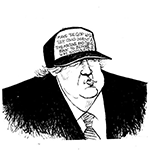A bigger House? First of all, where would everyone sit?
Published in Political News
WASHINGTON — The typical House office suite consists of three rooms: the member’s office, the main reception area and the “leg shop,” where as many as eight staffers might be jammed. Interns are sometimes relegated to supply closets.
These can be chaotic workspaces and aren’t always conducive to hosting constituents or simply taking phone calls, according to Taylor Swift, director of government capacity at POPVOX Foundation and a Hill veteran.
“I’ve worked in personal offices and leadership offices, and in both instances it felt like they were just co-working spaces,” Swift said. “Don’t get me wrong, that presents a great opportunity, especially if you’re new to the Hill, to be introduced to such a cool environment. But it’s also sometimes a difficult place to get work done.”
Some are dreaming bigger — much bigger. A new report, published Monday by POPVOX and fellow nonprofit Protect Democracy, explores the idea of expanding not only the campus’ physical footprint, but also the chamber’s membership.
The size of the House is not mandated by the Constitution, as the report notes, and until the early 1900s, its membership increased regularly as the country’s population grew. That stopped when a freeze was put in place in 1929, though debates about proportional representation and congressional capacity remain.
This project imagines a different future, said Drew Penrose, a policy strategist at Protect Democracy. Without taking a position on whether the House should expand (Penrose said Protect Democracy supports it, but Swift and POPVOX abstain), it probes the logistics of adding an extra 150 representatives.
“Few people talking about that issue had really addressed head-on the question of, what’s it going to take?” Penrose said. “One of the first questions we would get when talking to people on the Hill was, ‘Where are they going to sit?’”
The answer to that hypothetical question, according to the report authors, could be a brand-new House office building located south of Cannon.
Via architectural renderings, the report envisions a modern workspace (inspired partly by the Hart Senate Office Building) to accommodate as many as 200 additional members, as well as committee and staff offices. It could be built on an existing parking lot that, until 2002, housed the original O’Neill Building, which is now located several blocks west.
Such a building could have a courtyard and “a striking tower, adding several stories of office space with beautiful views of the Campus (but still well below the height of the Capitol),” according to the report.
“We were really excited at the idea of working with an architect and starting to have practical visions of what this can be,” Swift said. “Because it’s really hard for staff and members of Congress to be forward facing in this way … because they’re dealing with so many day-to-day consequential ideas and policies. So we thought this was the perfect opportunity to create something practical that was easy for people to digest.”
Protect Democracy and POPVOX partnered with Firsthand, a team of designers and social scientists, and conducted interviews with members, staffers, experts and policy advocates. They identified a series of physical limitations, including the size of the House floor, lack of functional work space and isolation of the “lower campus,” which includes the O’Neill and Ford buildings.
The report argues increased capacity in the House chamber could be achieved by adding stairs and opening up balcony seating to members in certain circumstances. It proposes additional coworking spaces (some of which are already being constructed) and better use of outdoor and courtyard spaces, including potentially installing a glass dome over Rayburn courtyard. And it suggests building an elevated walkway to connect the lower campus, where increasingly more resources are located, including the House Child Care Center.
“The accessibility to all those buildings down there, we thought was really, really important,” Swift said.
Call it pie-in-the-sky, but there is at least some support for expansion within the halls of Congress.
In early 2023, Illinois Democratic Rep. Sean Casten proposed legislation that would have added around 138 new members of the House. Around the same time, Oregon Democratic Rep. Earl Blumenauer introduced a measure to lift the “artificial cap” on House members. That bill would have increased the number of House seats to 585 and would have ordered the Architect of the Capitol to submit a report and recommendations to Congress on facility needs.
Casten and Blumenauer each cosponsored the other’s bill, but support was otherwise muted, and neither piece of legislation has been taken up in committee.
Both lawmakers noted the number of constituents living in a single congressional district has skyrocketed since the country’s founding, when George Washington set a target of 30,000 people per representative.
Adhering to those same standards would result in a prohibitively large legislative body, many argue. Adding more members also could come at a significant cost and have security implications, especially as Capitol Police struggle with increased threats.
“Getting America back to one representative for every 30,000 or even 50,000 constituents would produce a freakishly huge House along the lines of the Galactic Senate in Star Wars,” Kevin R. Kosar, a senior fellow at the American Enterprise Institute, wrote in a 2022 op-ed in The Hill, while calling the idea of a more modest expansion “intriguing.”
Swift and Penrose are under no illusions that the report will prompt an immediate change. But they hope to at least start the conversation.
“It is very much still at the thought-generation phase,” Penrose said. “There’s a real hesitancy for Congress to invest in itself, from the perspective of stewardship of tax dollars. But part of what we’re trying to do here is say that actually there’s a real pro-democratic value to this.”
©2024 CQ-Roll Call, Inc., All Rights Reserved. Visit cqrollcall.com. Distributed by Tribune Content Agency, LLC.




























































Comments